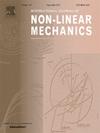High order invariant manifold model reduction for systems with non-polynomial non-linearities: Geometrically exact finite element structures and validity limit
IF 2.8
3区 工程技术
Q2 MECHANICS
International Journal of Non-Linear Mechanics
Pub Date : 2025-05-31
DOI:10.1016/j.ijnonlinmec.2025.105138
引用次数: 0
Abstract
This paper considers the computation of reduced-order models for systems of ordinary differential equations that include non-polynomial non-linearities. A targeted example is the case of a geometrically exact model of highly flexible slender structure, that includes, after space discretisation, trigonometric non-linear terms. With a suitable change of variables, this system can be rewritten in an equivalent one with polynomial non-linearities at most quadratic, at the price of introducing additional variables linked to algebraic equations, leading to a differential algebraic set of equations (DAE) to be solved. This DAE is reduced thanks to a normal form parametrisation of its invariant manifolds and selecting a set of master ones. Arbitrary order expansions are detailed for the coefficients of the change of variable and the reduced dynamics, using linear algebra in the space of multivariate polynomials of a given degree. In the case of a single non-linear mode reduction, a criterion to evaluate the quality of the normal form results is also proposed based on an estimation of the convergence radius of the polynomial asymptotic expansion representing truncated series. The method is then applied to compute a single mode reduction of three test cases – a Duffing oscillator, a simple pendulum and a clamped clamped beam with von Kármán model –, in order to investigate the effect of the algebraic part of the DAE on the quality of the model reduction and its validity range. Then, the more involved case of a cantilever beam modelled by geometrically exact finite elements is considered, underlining the ability of the method to produce accurate and converged results in a range of amplitude that can be bounded thanks to a convergence criterion.
非多项式非线性系统的高阶不变流形模型约简:几何精确有限元结构与有效性限制
研究含非多项式非线性的常微分方程系统的降阶模型的计算。一个有针对性的例子是高度灵活的细长结构的几何精确模型,其中包括经过空间离散化的三角非线性项。通过适当的变量变换,该系统可以被重写为一个多项式非线性的等效系统,其代价是引入与代数方程相关的额外变量,从而导致求解微分代数方程组(DAE)。由于对其不变流形进行了正规的参数化,并选择了一组主流形,因此减小了DAE。在给定次数的多元多项式空间中,利用线性代数详细地对变量变化系数和简化动力学进行了任意阶展开。在单非线性模态约简的情况下,基于截断级数的多项式渐近展开式的收敛半径估计,提出了一个评价范式结果质量的准则。将该方法应用于Duffing振子、单摆和箝位梁三个测试用例的von Kármán模型的单模约简计算,以探讨DAE的代数部分对模型约简质量及其有效范围的影响。然后,考虑了更复杂的由几何精确有限元建模的悬臂梁的情况,强调了该方法在可以由于收敛准则而有界的幅度范围内产生准确和收敛结果的能力。
本文章由计算机程序翻译,如有差异,请以英文原文为准。
求助全文
约1分钟内获得全文
求助全文
来源期刊
CiteScore
5.50
自引率
9.40%
发文量
192
审稿时长
67 days
期刊介绍:
The International Journal of Non-Linear Mechanics provides a specific medium for dissemination of high-quality research results in the various areas of theoretical, applied, and experimental mechanics of solids, fluids, structures, and systems where the phenomena are inherently non-linear.
The journal brings together original results in non-linear problems in elasticity, plasticity, dynamics, vibrations, wave-propagation, rheology, fluid-structure interaction systems, stability, biomechanics, micro- and nano-structures, materials, metamaterials, and in other diverse areas.
Papers may be analytical, computational or experimental in nature. Treatments of non-linear differential equations wherein solutions and properties of solutions are emphasized but physical aspects are not adequately relevant, will not be considered for possible publication. Both deterministic and stochastic approaches are fostered. Contributions pertaining to both established and emerging fields are encouraged.

 求助内容:
求助内容: 应助结果提醒方式:
应助结果提醒方式:


